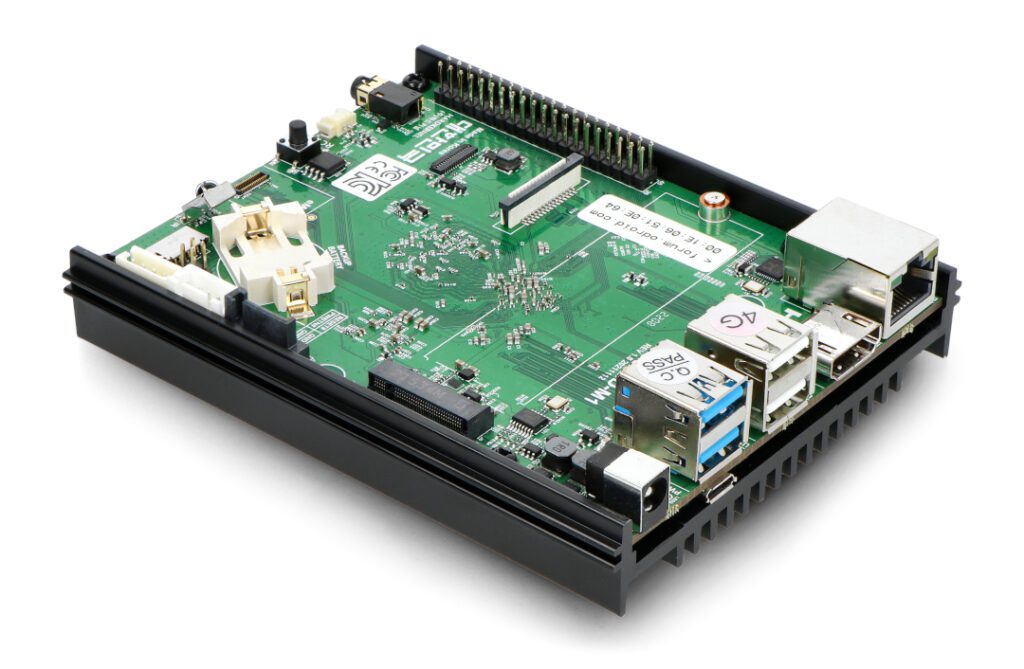Table of Contents:
Modern single-board computers, becoming an increasingly popular tool among electronics enthusiasts, offer almost unlimited possibilities for creating advanced projects.
The Odroid M1 stands out not only because of its compact form factor, but also because of its impressive performance, which makes it an excellent choice for both experienced engineers and those who are just beginning their adventure with microprocessors. What is worth knowing about it? What is it used for and in what areas can it be used?
Check out the answers to some of the most important questions and discover the capabilities of the Odroid M1 minicomputer.
What is the Odroid M1?
Odroid M1 is an innovative single-board minicomputer that has already carved out an excellent reputation among many electronics enthusiasts.
Equipped with advanced technologies and impressive capabilities, the Odroid M1 offers amateurs and professionals a wide range of applications.
With a quad-core Cortex-A55 processor and Mali-G52 GPU for high performance as well as low power consumption, it is the ideal tool for a variety of DIY projects and industrial applications.
In addition, the Odroid M1 is distinguished by a rich set of interfaces, such as:
- eMMC connectors,
- microSD,
- Ethernet,
- HDMI,
- USB 3.0.
This allows for easy connection and integration with other devices.
As a result, the Odroid M1 becomes not only a versatile tool for experimenting with electronics, but also a solid foundation for advanced projects.
Anatomy of the Odroid M1 single board computer
The design of the Odroid M1 minicomputer relies on a comprehensive approach to technical specifications, composed of advanced components that make this board an extremely powerful tool in the world of electronics.
Its centerpiece is a quad-core Rockchip RK3568B2 processor, which operates with impressive power.
On the market you will find versions of the Odroid M1 equipped with 4 or 8 GB of RAM.
Whichever variant you choose, you will ensure smooth switching between tasks and efficient data management.
An important part of the Odroid M1 ‘s anatomy is also the Mali-G52 MP2 GPU with 4 execution engines, reaching up to 650 MHz.
It is what allows you to enjoy excellent graphics quality in your projects.
With the wide range of mentioned interfaces, this board can easily cooperate with other devices, which greatly expands its range of functions.
The whole is a harmonious and comprehensive structure that puts the Odroid M1 at the forefront of modern single-board minicomputers.
Odroid M1 minicomputer a Petitboot
Odroid M1 board is distinguished not only by its advanced components, but also by its pre-installed Petitboot program, which makes this model extremely friendly for enthusiasts and professionals.
Petitboot is a special bootloader that allows easy management of different versions of the operating system.
It works with storage devices such as microSD, eMMC, NVMe, SATA and USB, giving you a lot of freedom in your choice of system media.
With Petitboot, the operating system installation process has become extremely intuitive.
This program allows you to run different operating systems from multiple sources, eliminating the need for complicated and time-consuming flashing of the operating system image.
In addition, the ability to install an operating system online over the network makes the whole procedure more efficient and in line with modern standards.
In practice, Petitboot on the Odroid M1 gives you full control over the choice of operating system, which is crucial especially if you like to experiment with different configurations or DIY projects.
With this feature, the Odroid M1 becomes not only a minicomputer with impressive computing power, but also a tool that can be customized according to the user’s individual needs and preferences.
How can the Odroid M1 be used?
The microcomputer described Odroid M1, with its powerful processing capabilities and versatile connectivity options, is ideal as a platform for software development and prototyping.
Experienced electronics enthusiasts also use this model for automation projects, creating, for example, smart solutions for their home.
In addition, the Odroid M1’s high performance GPU and HDMI outputs can be turned into a small multimedia center, supporting high-quality video playback and streaming.
The M1’s compact size and broad functionality also make it an ideal choice for educational purposes, allowing students or enthusiasts to explore programming and electronics, especially in DIY projects.
Importantly, additional accessories can be purchased for the Odroid board, such as an aesthetically pleasing case and power cord, which further expand the device’s functionality.
How useful was this post?
Click on a star to rate it!
Average rating 4 / 5. Vote count: 1
No votes so far! Be the first to rate this post.




















